How To Can Diced Tomatoes
This post may contain affiliate links. See my disclosure policy.
There are several reasons it’s a great idea to can your own tomatoes.
The first reason is this: BPA’s. Nearly everyone’s heard of this chemical because of the health risks associated with it. Sadly it continues to be used in so many of our food products. In the case of tomatoes, it’s used in the lining of the cans. Because tomatoes are high in acid, the BPA is more likely to leach out.
So what about cans that advertise BPA-free? Sure, they’ve removed the BPA but in doing so simply replaced it with another chemical called BPS-Bisphenol S. that comes with many of the same health risks.
The good news: Food in GLASS jars is SAFE from chemicals.
Another reason is quality and freshness. You have complete control over which tomatoes you select to go into the jars. Choose the best and you have a superior product.
Lastly, if you’re able to find a good deal on bulk tomatoes, you can bottle your own for the same or less than what you pay for them in the store AND they’re fresher AND are free from those nasty chemicals. It’s a win-win!
Let’s get started!
Bring a large pot of water to a boil. Using a knife, cut a small “x” in the bottom of each tomato and drop the tomatoes in the boiling water, a few at a time, for 30-60 seconds. Lift them out with a slotted spoon and put them directly into a bowl of ice water so they can cool quickly.
Once cool enough to handle, peel the tomatoes. Having blanched the tomatoes, the peels will now slip off easily. Discard the peels.
Cut out the stem part of the tomato and dice the tomatoes.
Place the diced tomatoes and tomato juices into a large pot and bring it to a boil. Boil the tomatoes for 5 minutes to release their juices. Note: If you’re canning crushed tomatoes the process is the same, simply boil a little longer and use a potato masher to crush the tomatoes.
Have the canning jars ready: Sterilized and hot. Place one tablespoon of bottled lemon juice (not fresh) OR 1/4 teaspoon citric acid in each pint jar or two tablespoons lemon juice OR 1/2 teaspoon citric acid in each quart jar.
Pack the hot diced tomatoes and their juices in the hot sterilized jars, leaving 1/2 inch headspace from the top of the jar.
Optional, Salt: Place 1/2 teaspoon of kosher salt in each pint jar or 1 teaspoon in each quart jar.
Use a slim utensil like a butter knife to slide down into the jars to remove any air bubbles. Wipe the rims of each jar and screw on the canning lids/bands.
Place the jars in the boiling water bath canner and process for 35 minutes for pints and 45 minutes for quarts, adjusting for altitude. Remove the jars, being careful not to tilt them. Let them sit undisturbed for 24 hours then check the seals.
These diced tomatoes will keep in a cool place for at least a year.
Save This Recipe
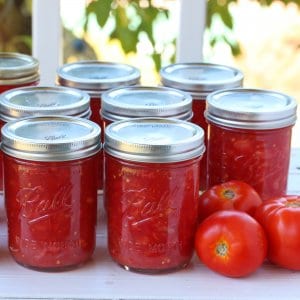
How To Can Diced Tomatoes
Ingredients
- Fresh tomatoes figure on roughly 2-3/4 lbs tomatoes per quart jar
- Bottled lemon juice or citric acid: 2 tablespoons bottled lemon juice per quart jar or 1 tablespoon per pint jar OR 1/2 teaspoon citric acid per quart jar or 1/4 teaspoon per pint jar
- Salt optional: 1 teaspoon per quart or 1/2 teaspoon per pint jar
Instructions
- Bring a large pot of water to a boil. Using a knife, cut a small "x" in the bottom of each tomato and drop the tomatoes in the boiling water, a few at a time, for 30-60 seconds. Lift them out with a slotted spoon and put them directly into a bowl of ice water so they can cool quickly.
- Once cool enough to handle, peel the tomatoes. Having blanched the tomatoes, the skins will now slip off easily (removing the skins is the standard recommendation because it's the skins that harbor potential bacteria). Discard the skins. Cut out the stem part of the tomato and dice the tomatoes.
- Place the diced tomatoes and tomato juices into a large pot and bring it to a boil. Boil the tomatoes for 5 minutes to release their juices.
- Have the canning jars ready (sterilized and hot). Place one tablespoon of bottled lemon juice (not fresh) OR 1/4 teaspoon citric acid in each pint jar or two tablespoons lemon juice OR 1/2 teaspoon citric acid in each quart jar.
- Pack the hot diced tomatoes and their juices in the hot sterilized jars, leaving 1/2 inch headspace from the top of the jar.
- Optional, Salt: Place 1/2 teaspoon of kosher salt in each pint jar or 1 teaspoon in each quart jar.
- Use a slim utensil like a butter knife to slide down into the jars to remove any air bubbles. Wipe the rims of each jar and screw on the canning lids/bands.
- Place the jars in the boiling water bath canner and process for 35 minutes for pints and 45 minutes for quarts, adjusting for altitude. Remove the jars, being careful not to tilt them. Let them sit undisturbed for 24 hours then check the seals.
- These diced tomatoes will keep in a cool place for at least a year.

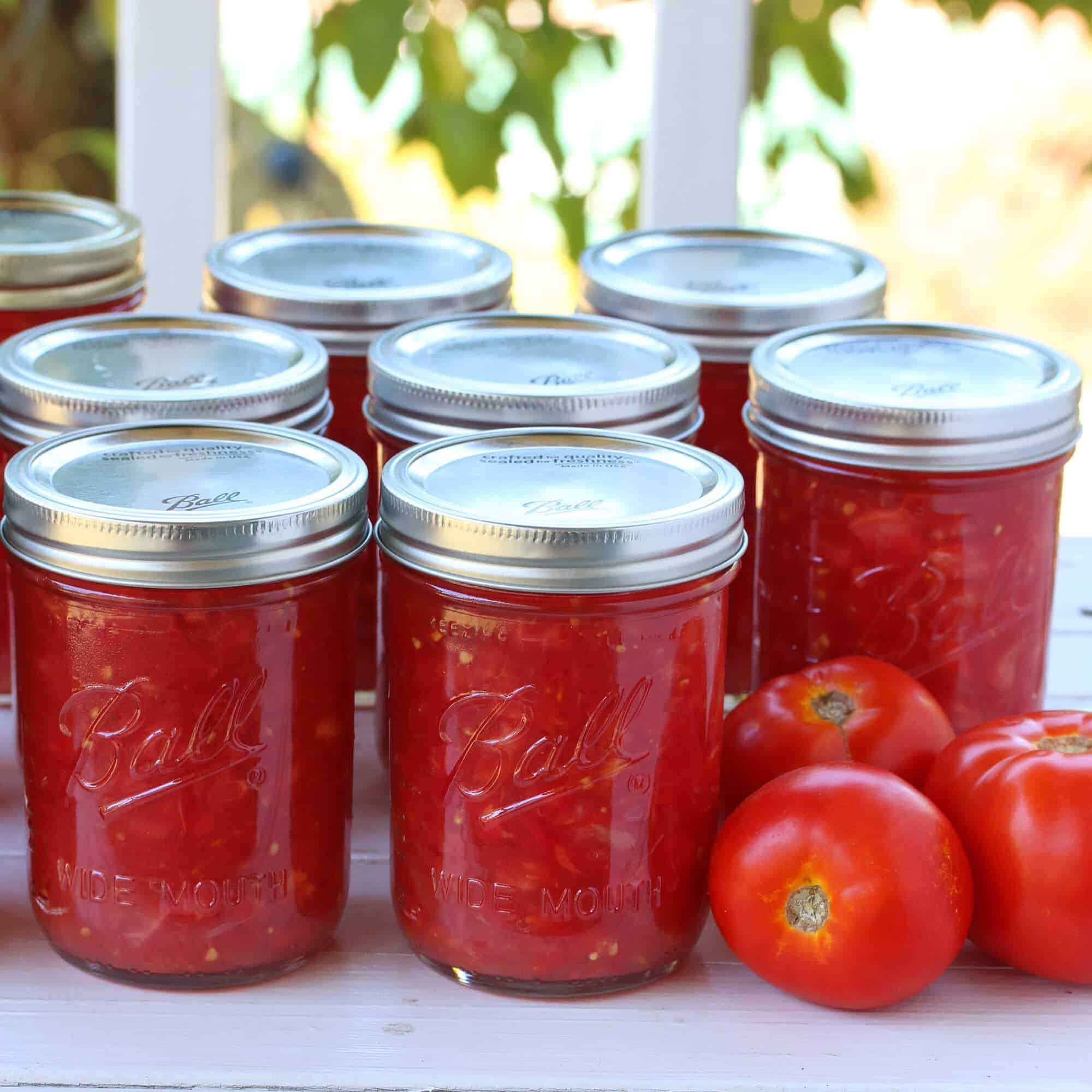
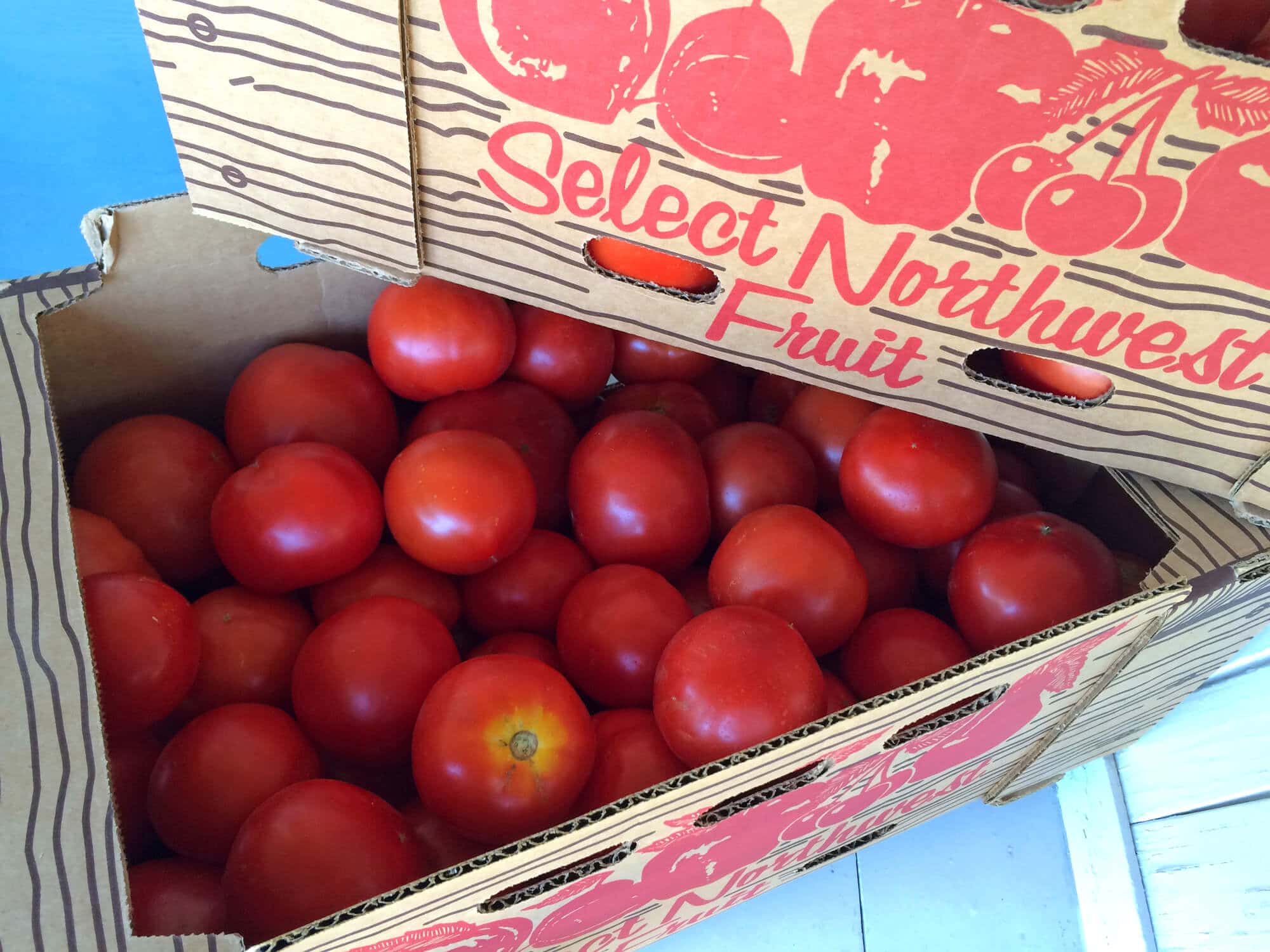
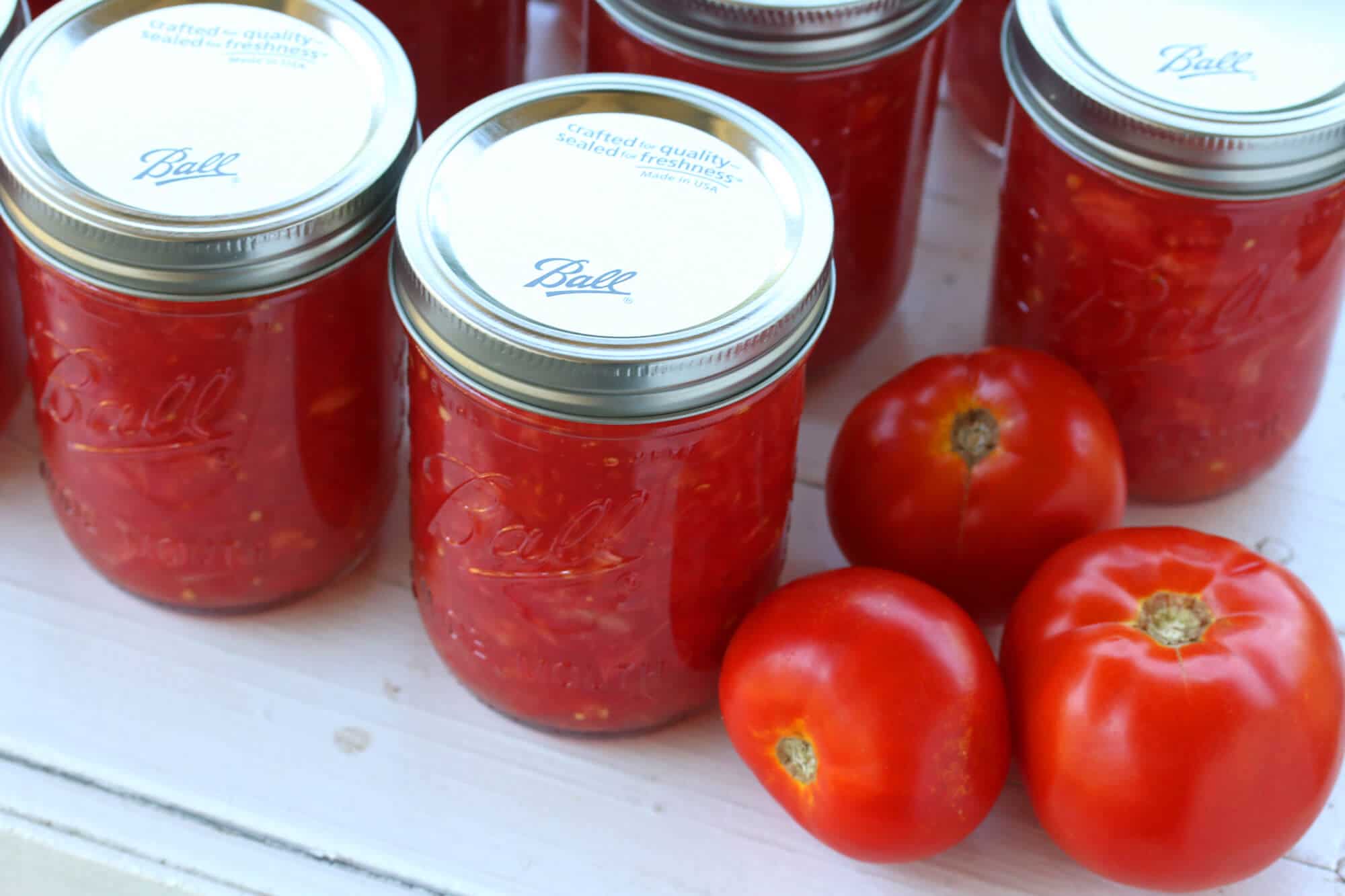

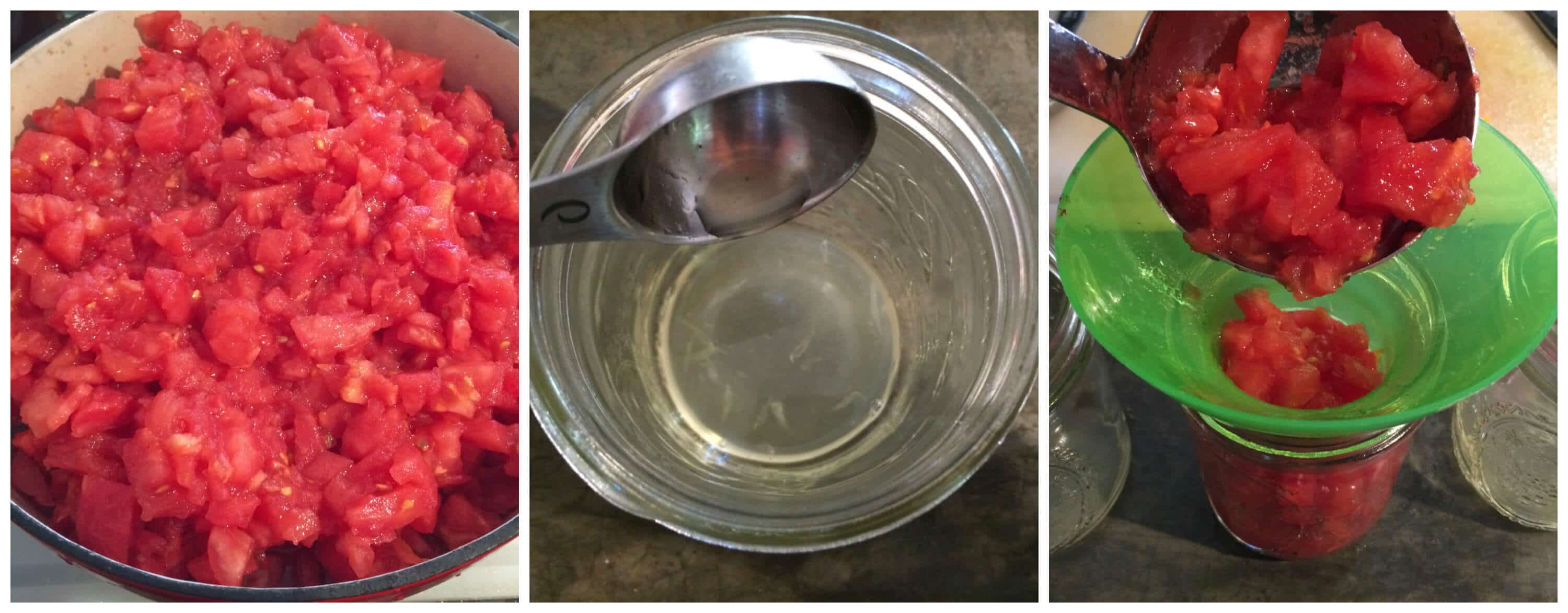
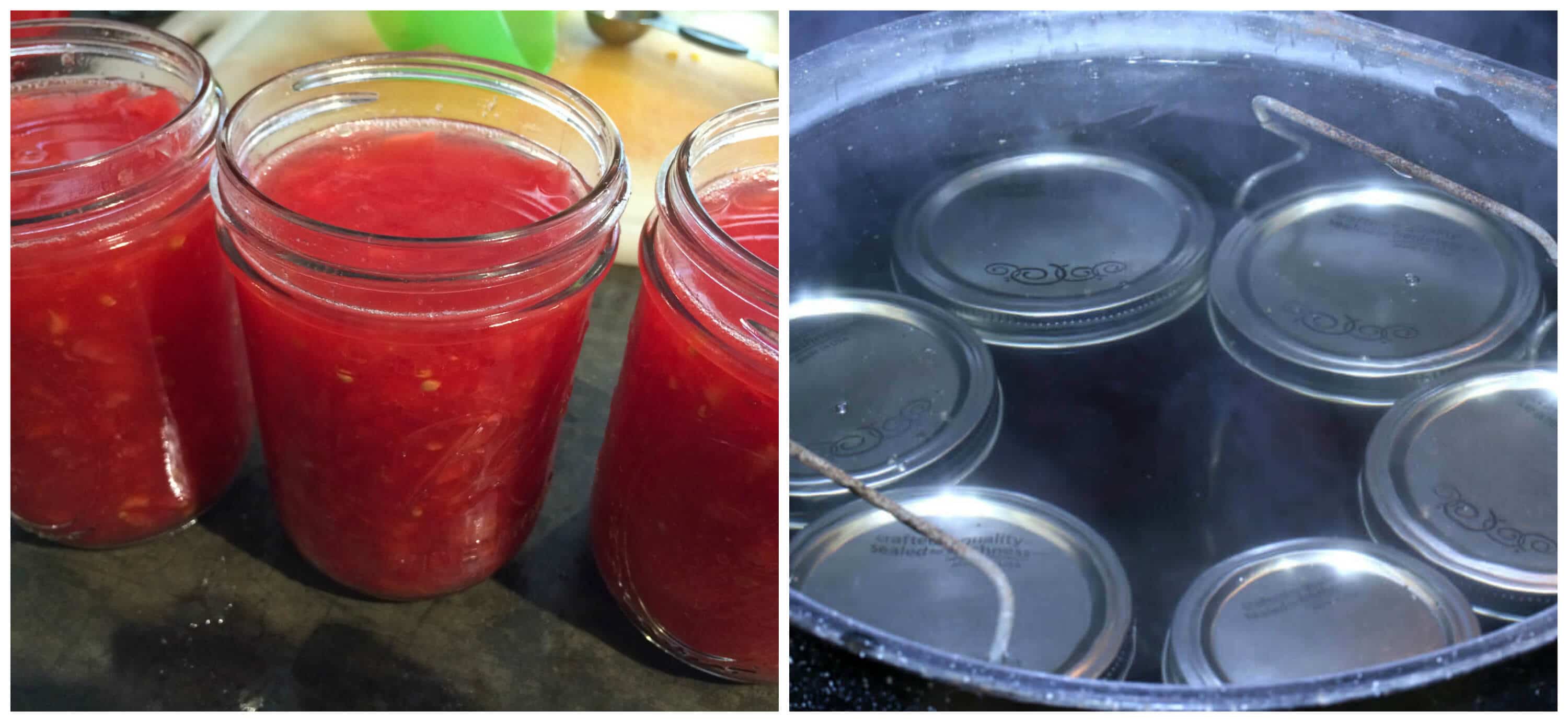
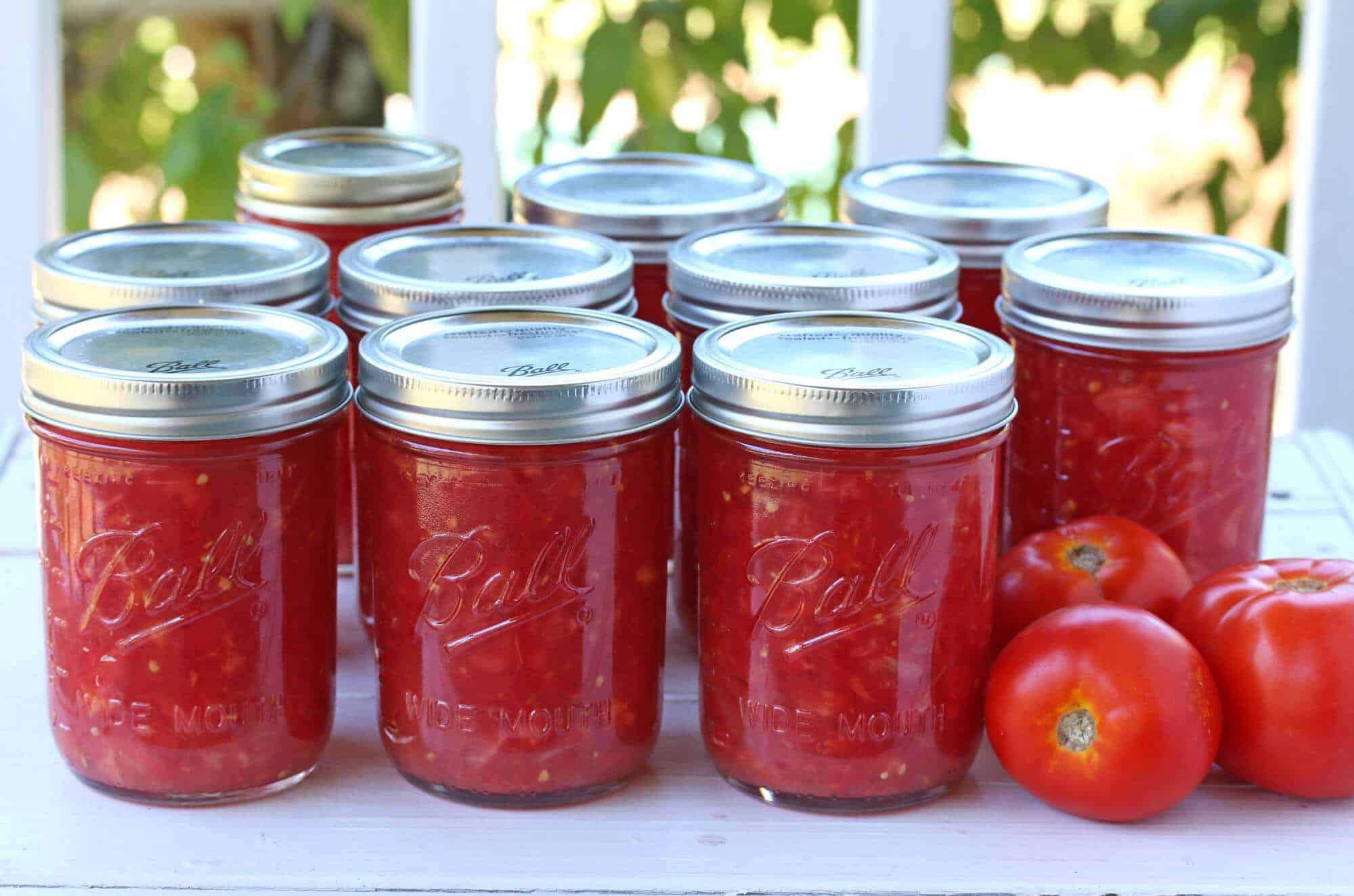


















Can you use fresh onions peppers and garlic and still water bath?
NO! adding any other vegetables to tomatoes requires you to use a pressure canner.
Thank you for sharing all this information. Is it safe to add spices such as fresh rosemary, basil and onions to the canned tomatoes?
I would also like to know what the best type of tomato to use is. It will be my first time canning.
Hi Jennifer, you can use any tomato you like but generally varieties that are “meatier” with a lower water content are ideal, like Roma tomatoes.
Thank you for this recipe! The Ball Book of Canning does not require removing the skins from the tomatoes. I have done both ways in making my sauces. It’s nice to know I can now use up the remainder of my tomatoes into diced canned tomatoes as I have made mild, medium, hot and REALLY hot salsa and wanted to just have some canned tomatoes to use when my recipes call for them. KUDOS to you!
What are best type of tomatoes to use? Would you use a mixture?
This is actually giving out erroneous information. There is no tested safe method for canning diced tomatoes in their own juice. Only quartered, halved, or whole. The skins must also be removed, it’s not optional. Diced tomatoes, and leaving the peels on both create density issues. Dr Elizabeth Andress can confirm this and is very responsive to emails. Here is a response directly from Ball when asked about canning diced tomatoes
We appreciate your inquiry about how to can diced tomatoes only – no other vegetables added. At this time, we do not have a tested recipe for diced tomatoes, nor do we have instructions or guidelines on processing time or method (water-bath / pressure canner). It becomes a density and food safety issue. There would be more diced tomatoes in a jar than quartered or halved tomatoes – making the finished product more dense, which may then require a different processing time and/or method to ensure food safety.
Following is an explanation of the different tomato recipes available:
Tomatoes in Water are just room-temperature tomatoes placed in a jar, then water is added to the required headspace; This recipe has the least density, thus it will take the least processing time of the (3) recipes.
Crushed Tomatoes are more dense than tomatoes-in-water, but the tomatoes are heated and crushed in the pan at that same time, then the jars are filled to the correct headspace. These tomatoes are less dense than tomatoes-in-own-juice; therefore, the extended processing time is not necessary.
Tomatoes in Own Juice are room-temperature tomatoes placed in the jar and then pressed down to release the juices; this is repeated until tomatoes reach the required headspace. This recipe is the most dense of the three, with an appearance similar to tomato sauce; therefore it requires a much longer processing time.
If you desire to preserve diced tomatoes only, we recommend putting them in a freezer-safe jar or container and freeze for up to 1 year to ensure food safety. We hope this information is helpful. Have a great weekend!
Sincerely,
Sherry
Hi Sherry (or is it Lurley?), you say that “only quartered, halved, or whole” tomatoes can safely be canned, yet Ball itself has a recipe for crushed tomatoes: https://www.freshpreserving.com/crushed-tomatoes-%7C-canning-tomatoes—ball-fresh-preserving-br1149.html.
Also, if density is the supposed issue here, how do they justify crushed tomatoes? Or tomato sauce for that matter? What you say is Ball’s response doesn’t make any sense: “[Diced tomatoes] becomes a density and food safety issue. There would be more diced tomatoes in a jar than quartered or halved tomatoes.” On the density spectrum, here’s the breakdown in order from least to greatest density: Whole, halved, quartered, diced, crushed, sauce. You’re saying the first 3 and last 2 are approved (Ball says crushed is approved), yet diced, which lies in the very middle, is somehow not safe? Now that’s just not remotely logical, is it?
What I read was they don’t have facts on diced, so they give the facts on what they do.
Can you add fresh basil
Hi Mary, absolutely!
Thank you
This is my first time canning tomatoes, I’m very excited
Awesome! The important thing is to be sure to include the right amount of either bottled lemon juice or citric acid. Happy canning! :)
Thanks for the easy tutorial. I made my first batch of canned diced tomatoes following your instructions. From a pre-eaten point of view, everything went very well!
Awesome, Charles, congrats on your first batch!
Any suggestions to get rid of the tomato seeds?
Hi, I don’t use bottled lemon juice or citric acid, but I have 6% vinegar, presumably that would be a good substitute?
Thanks.
Do you know what the patent jars with reusable glass kids and metal rings are called? I don’t want to be tied into buying metal lids :)
Hi tj, the sources I’ve read say you should use 4 tablespoons of 5% vinegar (not 6%) per quart to ensure the correct pH level for safe canning. That’s a lot of vinegar and would obviously impact the flavor of the tomatoes, but that is an alternative option.
That’s great, thanks for your reply, I am just about to preserve some now and I sometimes putca little sugar and vinegar into my fresh tomato sauces so to give zing, so it’ll probably be fine:)
Excellent tutorial! It’s been years since I’ve canned tomatoes. But I couldn’t pass up the sale I found this morning. :)
Thanks so much.
Hi, I didn’t see these instructions first.. I watched a YouTube video and canned tomatoes. I blanched and removed the skins and stems but I didn’t ‘cook’ my tomatoes before canning them. They look good except for the fact that they sperated. I used the wide mouth jars. Do you think they will be ok since I didn’t cook them for 5 minutes first? They only come in the jars for 40 minutes.
Hi Kathleen, that’s fine as long as you still used either citric acid or lemon juice. The method is the difference between what is called “raw pack” versus “cold pack.” And yes, using wide mouth jars can sometimes result in the tomatoes floating to the top and the liquid being at the bottom, that’s normal and it’s perfectly safe. You can help avoid that from happening by using regular mouth jars because the diagonal slant toward the mouth will help push the tomatoes down.
Thanks!! I will be using the recipe this week with all the romas from my garden. Thanks for explaining the blanching process. I always forget.
Hi Kimberly! My tomatoes and the liquid separated after they cooled. So basically there is liquid in the bottom of the jars and the tomatoes at the top. Is this normal? And is it still ok to eat? The jar lids processed correctly. This is my first time canning so I want to make sure I’m not going to make my family sick! :)
Hi Kristen, yes, they’re perfectly safe and that’s something virtually every canner experiences at some point. Using regular jars (instead of wide-mouth jars) can help prevent that because the “shoulders” at the top of the jar help push the tomatoes down, but sometimes it just happens anyway.
Awesome instructions..turned out great
Fantastic, Jo, thank you!
Is it necessary to remove the skins?
Hi Kathleen, no, you can leave the skins on if you prefer.